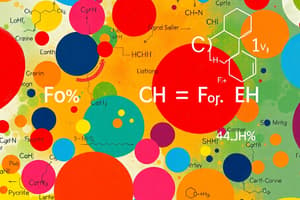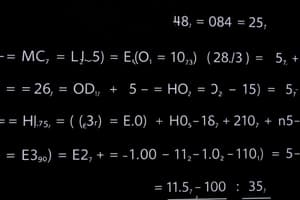Podcast
Questions and Answers
What is the empirical formula for dinitrogen tetroxide (N2O4)?
What is the empirical formula for dinitrogen tetroxide (N2O4)?
NO2
What is the empirical formula of a compound that consists of 40.0% carbon, 53.4% oxygen, and 6.6% hydrogen?
What is the empirical formula of a compound that consists of 40.0% carbon, 53.4% oxygen, and 6.6% hydrogen?
COH2
What is the formula that shows the elements in a compound in their lowest whole-number ratio?
What is the formula that shows the elements in a compound in their lowest whole-number ratio?
empirical formula
What is the empirical formula of a compound that consists of 72.4% iron and 27.6% oxygen?
What is the empirical formula of a compound that consists of 72.4% iron and 27.6% oxygen?
What is the empirical formula for mercury(I) peroxide (Hg2O2)?
What is the empirical formula for mercury(I) peroxide (Hg2O2)?
What is the empirical formula of a compound that consists of 3.6 g carbon, 2.4 g oxygen, and 0.9 g hydrogen?
What is the empirical formula of a compound that consists of 3.6 g carbon, 2.4 g oxygen, and 0.9 g hydrogen?
What is the empirical formula of a compound that consists of 32.00% carbon, 42.66% oxygen, 18.67% nitrogen, and 6.67% hydrogen?
What is the empirical formula of a compound that consists of 32.00% carbon, 42.66% oxygen, 18.67% nitrogen, and 6.67% hydrogen?
What is the empirical formula for glucose (C6H12O6)?
What is the empirical formula for glucose (C6H12O6)?
What is the empirical formula of a compound that consists of 65.2% scandium and 34.8% oxygen?
What is the empirical formula of a compound that consists of 65.2% scandium and 34.8% oxygen?
If a compound has a molar mass of 90 g/mol and its empirical formula is CH2O, what is its molecular formula?
If a compound has a molar mass of 90 g/mol and its empirical formula is CH2O, what is its molecular formula?
If a compound has a molar mass of 472.2 g/mol and its empirical formula is HgCl, what is its molecular formula?
If a compound has a molar mass of 472.2 g/mol and its empirical formula is HgCl, what is its molecular formula?
What is the empirical formula of a compound that has a molar mass of 92 g/mol and is composed of 30.45% nitrogen and 69.55% oxygen?
What is the empirical formula of a compound that has a molar mass of 92 g/mol and is composed of 30.45% nitrogen and 69.55% oxygen?
What is the molecular formula of a compound with a molar mass of 92 g/mol and its empirical formula is NO2?
What is the molecular formula of a compound with a molar mass of 92 g/mol and its empirical formula is NO2?
What is the empirical formula of a compound with a molar mass of 88.12 g/mol, which is 54.53% carbon, 9.15% hydrogen, and 36.32% oxygen?
What is the empirical formula of a compound with a molar mass of 88.12 g/mol, which is 54.53% carbon, 9.15% hydrogen, and 36.32% oxygen?
What is the molecular formula of a compound with a molar mass of 88.12 g/mol and an empirical formula of C2H4O?
What is the molecular formula of a compound with a molar mass of 88.12 g/mol and an empirical formula of C2H4O?
If a compound has a molar mass of 146 g/mol and its empirical formula is C3H5O2, what is its molecular formula?
If a compound has a molar mass of 146 g/mol and its empirical formula is C3H5O2, what is its molecular formula?
Flashcards are hidden until you start studying
Study Notes
Empirical and Molecular Formulas
- Empirical formulas represent the simplest whole-number ratio of elements in a compound.
- Molecular formulas show the actual number of atoms of each element in a molecule.
Examples of Empirical Formulas
- Dinitrogen Tetroxide (N₂O₄): Empirical formula is NO₂.
- Carbon-Hydrogen-Oxygen Compound: 40% C, 53.4% O, 6.6% H leads to the empirical formula COH₂.
- Iron-Oxygen Compound: 72.4% Fe and 27.6% O gives Fe₃O₄.
- Mercury(I) Peroxide (Hg₂O₂): Empirical formula is HgO.
- Carbon-Oxygen-Hydrogen Compound with 3.6 g C, 2.4 g O, and 0.9 g H yields C₂OH₆.
Complex Compositions
- Compound with 32.00% C, 42.66% O, 18.67% N, 6.67% H: Empirical formula is C₂O₂NH₅.
- Glucose (C₆H₁₂O₆): Empirical formula is CH₂O.
- Scandium-Oxygen Compound: 65.2% Sc and 34.8% O results in Sc₂O₃.
Molecular Formulas and Molar Mass Calculations
- Compound with molar mass 90 g/mol and empirical formula CH₂O: Molecular formula is C₃H₆O₃.
- Compound with molar mass 472.2 g/mol and empirical formula HgCl: Molecular formula is Hg₂Cl₂.
- Compound with molar mass 92 g/mol (30.45% N, 69.55% O): Empirical formula NO₂, molecular formula N₂O₄.
- Carbon-Hydrogen-Oxygen Compound (molar mass 88.12 g/mol, 54.53% C, 9.15% H, 36.32% O): Empirical formula is C₂H₄O, molecular formula is C₄H₈O₂.
- Compound with molar mass 146 g/mol and empirical formula C₃H₅O₂: Molecular formula is C₆H₁₀O₄.
Key Takeaways
- Transition from empirical to molecular formulas generally involves determining the molar mass of empirical formula and comparing it with the compound's molar mass.
- Fractional compositions can lead to determining the empirical formula, which is essential for understanding compound compositions in chemistry.
Studying That Suits You
Use AI to generate personalized quizzes and flashcards to suit your learning preferences.



